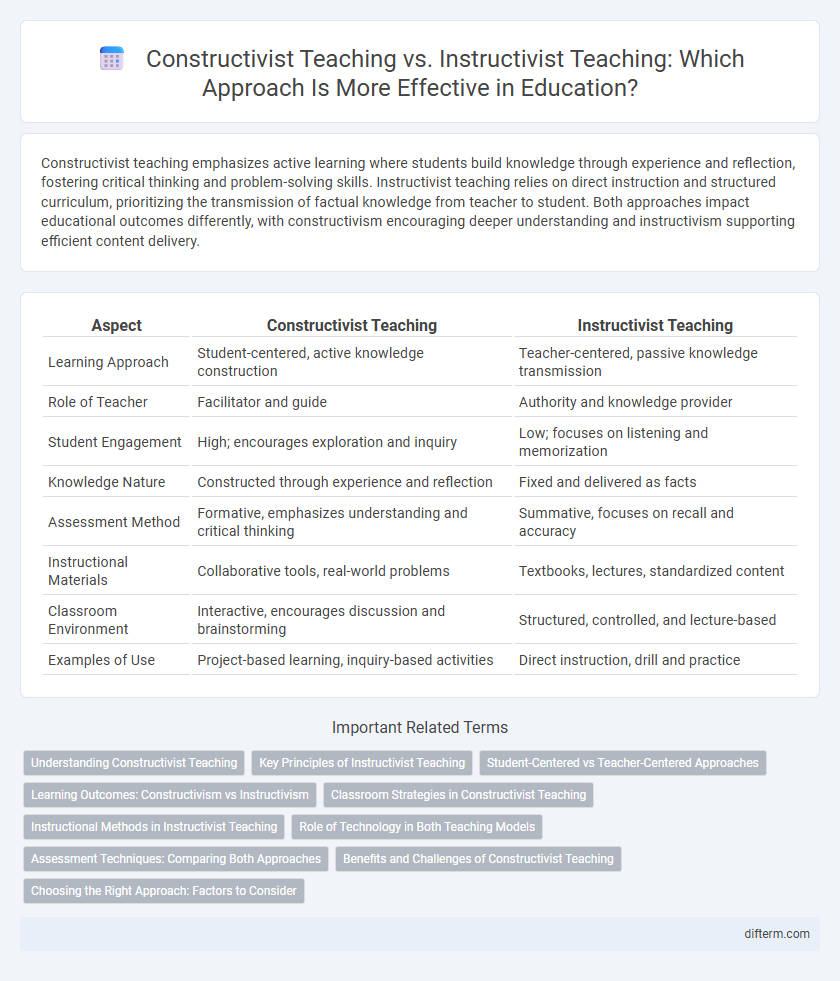Constructivist teaching emphasizes active learning where students build knowledge through experience and reflection, fostering critical thinking and problem-solving skills. Instructivist teaching relies on direct instruction and structured curriculum, prioritizing the transmission of factual knowledge from teacher to student. Both approaches impact educational outcomes differently, with constructivism encouraging deeper understanding and instructivism supporting efficient content delivery.
Table of Comparison
| Aspect | Constructivist Teaching | Instructivist Teaching |
|---|---|---|
| Learning Approach | Student-centered, active knowledge construction | Teacher-centered, passive knowledge transmission |
| Role of Teacher | Facilitator and guide | Authority and knowledge provider |
| Student Engagement | High; encourages exploration and inquiry | Low; focuses on listening and memorization |
| Knowledge Nature | Constructed through experience and reflection | Fixed and delivered as facts |
| Assessment Method | Formative, emphasizes understanding and critical thinking | Summative, focuses on recall and accuracy |
| Instructional Materials | Collaborative tools, real-world problems | Textbooks, lectures, standardized content |
| Classroom Environment | Interactive, encourages discussion and brainstorming | Structured, controlled, and lecture-based |
| Examples of Use | Project-based learning, inquiry-based activities | Direct instruction, drill and practice |
Understanding Constructivist Teaching
Constructivist teaching emphasizes active student engagement where learners build knowledge through experiences and reflection, contrasting with instructivist teaching's focus on direct instruction and memorization. This approach fosters critical thinking, problem-solving skills, and deeper conceptual understanding by encouraging collaboration and exploration in real-world contexts. Research shows that constructivist methods improve long-term retention and adapt to diverse learning styles, making education more personalized and meaningful.
Key Principles of Instructivist Teaching
Instructivist teaching centers on direct instruction where teachers deliver structured content and clear objectives, emphasizing the transmission of factual knowledge and skills. This approach operates on teacher control, systematic curriculum design, and the use of assessments to measure student learning outcomes effectively. Key principles include explicit teaching, repetition, immediate feedback, and maintaining a clear teacher-student hierarchy to ensure consistent mastery of material.
Student-Centered vs Teacher-Centered Approaches
Constructivist teaching emphasizes a student-centered approach, promoting active learning where students build knowledge through exploration and collaboration, fostering critical thinking and problem-solving skills. Instructivist teaching follows a teacher-centered model, focusing on direct instruction and structured content delivery to ensure efficient knowledge transfer. The shift towards constructivist methods aligns with contemporary educational goals of developing independent learners and adapting to diverse learning styles.
Learning Outcomes: Constructivism vs Instructivism
Constructivist teaching fosters deeper understanding and critical thinking by engaging students in active, collaborative learning experiences, leading to higher retention and application of knowledge. Instructivist teaching emphasizes direct transmission of information, often resulting in efficient acquisition of foundational skills but limited development of problem-solving abilities. Research indicates that constructivist approaches yield superior learning outcomes in complex cognitive tasks, while instructivist methods perform better for memorization and procedural knowledge.
Classroom Strategies in Constructivist Teaching
Classroom strategies in constructivist teaching emphasize active learning through collaboration, problem-solving, and hands-on activities that encourage students to construct their own understanding. Teachers act as facilitators, guiding inquiry and promoting critical thinking rather than delivering direct instruction. This learner-centered approach contrasts with instructivist teaching, which relies on structured lessons and rote memorization.
Instructional Methods in Instructivist Teaching
Instructivist teaching primarily relies on direct instruction where the teacher delivers content through lectures, demonstrations, and guided practice to ensure knowledge transmission. This method emphasizes structured lesson plans, clear objectives, and frequent assessments to measure student learning outcomes. It contrasts with constructivist approaches by focusing on teacher-led activities rather than student-driven exploration or discovery.
Role of Technology in Both Teaching Models
Technology in constructivist teaching fosters interactive, student-centered learning environments by enabling exploration, collaboration, and knowledge construction through digital tools and simulations. In instructivist teaching, technology serves primarily as a medium for delivering content and assessing understanding via multimedia presentations, digital textbooks, and automated testing platforms. Both models leverage educational technology, but constructivist approaches emphasize technology as a means to facilitate critical thinking and problem-solving, whereas instructivist methods use it to streamline information transmission and standardized evaluation.
Assessment Techniques: Comparing Both Approaches
Constructivist teaching employs formative assessment techniques such as portfolios, peer reviews, and reflective journals to promote active learning and critical thinking, while instructivist teaching relies heavily on summative assessments like standardized tests and quizzes to measure knowledge retention. In constructivist classrooms, assessments are integrated into the learning process, allowing students to demonstrate understanding through real-world problem-solving and project-based tasks. In contrast, instructivist approaches emphasize direct evaluation of factual recall and procedural skills through structured, objective tests that prioritize accuracy and coverage of content.
Benefits and Challenges of Constructivist Teaching
Constructivist teaching fosters critical thinking and problem-solving by encouraging students to actively engage and construct their own knowledge through real-world experiences. This approach promotes deeper understanding and retention, but it can be time-consuming and challenging to implement effectively in diverse classrooms with varying learning paces. Teachers must balance guidance with student autonomy while managing resources and assessment methods that support open-ended inquiry.
Choosing the Right Approach: Factors to Consider
Choosing between constructivist teaching and instructivist teaching depends on factors such as student learning styles, subject matter complexity, and classroom environment. Constructivist approaches thrive in settings where active exploration and critical thinking are encouraged, making them ideal for subjects requiring deep conceptual understanding. In contrast, instructivist methods suit situations needing clear, direct instruction and efficient knowledge transmission, particularly for foundational or procedural content.
constructivist teaching vs instructivist teaching Infographic

 difterm.com
difterm.com